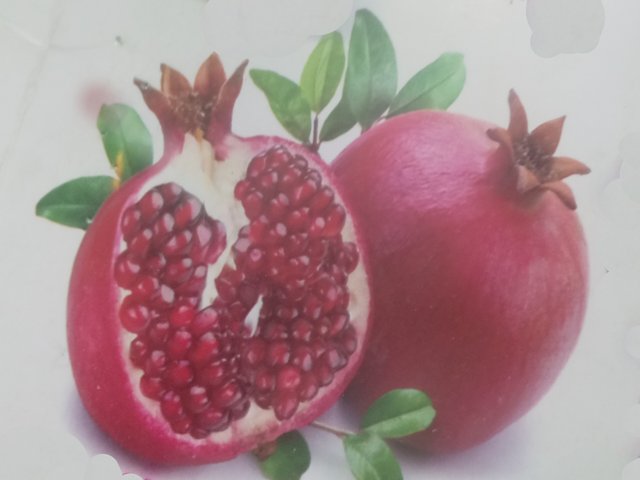A photography of Pomegranate
Anar: The Pomegranate
The pomegranate, scientifically known as Punica granatum, is a fruit-bearing deciduous shrub or small tree in the family Lythraceae. Native to the region from modern-day Iran to northern India, the pomegranate has been cultivated throughout the Mediterranean region and thrives in various parts of the world today. This remarkable fruit has not only been prized for its unique flavor and nutritional value but also for its rich cultural and historical significance.
Botanical Characteristics
Pomegranates typically grow between 5 and 10 meters in height. The fruit is a rounded berry, with a tough, leathery skin that ranges in color from deep red to yellowish-green. Inside, it is divided into compartments by white, spongy membranes filled with sacs of juicy seeds, or arils. Each aril contains a single seed surrounded by sweet, tangy juice. The plant’s vibrant flowers, usually red but sometimes white, add to its ornamental appeal.
Nutritional Profile and Health Benefits
Pomegranates are renowned for their high antioxidant content. They are rich in vitamins C and K, folate, and fiber. The antioxidants, primarily punicalagins and anthocyanins, have been linked to numerous health benefits, including anti-inflammatory properties and a reduced risk of heart disease. Pomegranate juice, in particular, has been shown to lower blood pressure and improve cholesterol levels, contributing to cardiovascular health.
Additionally, pomegranates possess anti-cancer properties. Studies suggest that pomegranate extracts can inhibit the growth of cancer cells and reduce the risk of prostate and breast cancers. The fruit also aids in digestion and can help prevent various gastrointestinal issues due to its fiber content.
Cultural and Historical Significance
Throughout history, the pomegranate has held significant cultural and religious symbolism. In ancient Egypt, it was a symbol of prosperity and ambition. Pomegranates were often placed in tombs as a sign of life after death. In Greek mythology, the fruit is associated with the story of Persephone, symbolizing the changing seasons and the cycle of life and death.
In the Bible, the pomegranate is mentioned multiple times, representing fertility and abundance. In Islamic tradition, it is considered a fruit from paradise and is often associated with themes of righteousness and beauty.
Culinary Uses
Culinarily, pomegranates are incredibly versatile. The arils can be eaten fresh, adding a burst of flavor to salads, desserts, and dishes. Pomegranate juice is popular worldwide, either consumed fresh or used as a base for sauces and marinades. In Middle Eastern and Mediterranean cuisines, pomegranate molasses, a thick, tangy syrup, is a common ingredient, providing a distinctive flavor to various dishes.
Economic and Agricultural Impact
Pomegranates are commercially cultivated in many parts of the world, including the United States, Spain, India, and Iran. The demand for pomegranates has surged in recent years due to their health benefits and culinary versatility, making them a lucrative crop for farmers. Modern agricultural practices and breeding programs focus on improving fruit quality, yield, and disease resistance to meet the growing market demands.
Conclusion
The pomegranate stands out not only for its delicious taste and health benefits but also for its deep-rooted cultural and historical significance. As interest in healthy eating continues to rise, this ancient fruit is experiencing a renaissance, being celebrated both for its nutritional profile and its culinary applications. Whether enjoyed fresh, as juice, or in cooking, the pomegranate remains a timeless symbol of health, fertility, and prosperity.
